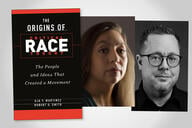You have /5 articles left.
Sign up for a free account or log in.
Even as Asian-American enrollments grow at leading American universities, relatively little in-depth work has been done that focuses on growing subgroups of those students. The Intimate University: Korean-American Students and the Problems of Segregation, recently published by Duke University Press, is an attempt to remedy that. In the book, Nancy Abelmann focuses on a large population of Korean-American students at the University of Illinois at Urbana-Champaign, where she is associate vice chancellor for research and the Harry E. Preble Professor of Anthropology, Asian-American Studies and East Asian Languages and Cultures. Abelmann responded to questions about her new book.
Q: How do you see Korean Americans' educational experience as distinct from that of other Asian American students, and from other minority students?
A: Like all students of color, among them Asian Americans at large, Korean Americans are racialized (i.e., marked in some way for their race). With all Asian Americans, Korean Americans share the experience of being sometimes considered members of the "model minority," namely exemplary students who succeed by virtue of their own efforts, and, in some versions of this perspective, the predispositions of their "culture/s." I argue, however, that today it is Asian Americans’ image as "instrumental strivers," namely students motivated principally by practical concerns and material rewards, that is more important, particularly so for Korean Americans. This racialized stereotype is foisted on Korean Americans in particular because of their high rates of self-entrepreneurship (e.g., green grocers, dry cleaners), indeed the highest in the United States. For Korean American students, these images fly in the face of what I dub their often deeply held "liberal dreams" for education, namely ideas of becoming broadly educated, cosmopolitan people. While these sorts of liberal dreams are shared by many Americans, I think they are disproportionately shared by Korean Americans whose parents hail from South Korea, a country whose modernity story is intimately tied to U.S. economic and political involvement and to an "American dream." To a considerable extent, these ideals make for what some scholars have dubbed "intra-ethnic othering," a process through which Korean Americans often distinguish themselves from a pejorative Korean American "mainstream."
Q: How crucial are family expectations to understanding the Korean-American university experience?
A: I think that family is important to the college lives of all students, especially traditional-aged students, but more so for students from immigrant families for whom college attendance in the United States fulfills an often long-embraced and hard-earned dream. As such, the promise and expectations of college are often richly elaborated in immigrant families in ways that can be weighty for the students themselves. Korean Americans, as I indicate above, come from families whose histories are enmeshed in South Korea’s U.S.-inflected modernity; they bring to college complex and sometimes contradictory expectations of college – to become both widely educated and able to practically succeed – tensions at the heart of American education more broadly. Also important to the university experience of many Korean Americans is extended family: as for many immigrants, many Korean Americans have navigated the United States in the dense company of immigrant kin.
Q: How key is the church role for Korean-Americans and how does that differ from the experiences of other minority and majority groups?
A: Over 60 percent Christian, Korean Americans are among the most Christian ethnic groups in the United States. South Korea is East Asia’s most Christian country (about a quarter of the population) and the church is the central support institution in Korean American communities. Although most church-attending Korean American college students grow up in church-attending families, I argue that ironically these students often challenge both family and university through their own ethnic student churches. Fashioning themselves as more authentically Christian than their parents – whose church attendance they often argue is instrumental in nature – they often look to the church to answer their liberal desires to become well-rounded human beings, interested in more than the material gain of the stereotype in which they are sometimes clothed. An additional irony, however, is that Korean Americans often attend largely "Korean" churches and worry that as such they are not sufficiently realizing the promise of the experience of "diversity" at college. Certainly religion has a place in the lives of many college students, but the specificity for Korean Americans is, to reiterate, that on the one hand the church offers a particular alternative to stereotypes of instrumental striving, while on the other hand it poses a problem for being oftentimes a largely Korean organization.
Q: You write about issues of segregation at the university. How do you see Korean-Americans differing from other groups on campus (whether explored by race and ethnicity or by interests)?
A: Indeed, many college students do not, in the words of many of my interlocutors, exit their "comfort zones" in college, be it because they stay with kids from their home towns, their race/ethnicities, or with kids who share particular interests (e.g., sports). The burden that Korean Americans share with some other racialized groups is that they are often troubled by their segregation (i.e., their often singularly ethnic social lives), worried that it somehow speaks to their own limitations and betrays the promise of college. It is in this sense that I consider these "racialized burdens." Most of my interlocutors either bemoaned their own “self segregation” or worked hard to distinguish themselves from the "mainstream" of their (more segregated) co-ethnics. It can perhaps be said that Asian Americans are more prone to talk personal responsibility for "self-segregation" because anti-Asian American racism is not widely recognized and named in the United States (e.g., vs. anti-black racism).
Q: How do Korean Americans experience stereotypes and worse in their university experience?
A: Korean Americans are burdened both by the aforementioned stereotype of the instrumental striver and by their sense that their segregation is seen by others as "self segregation." While some students did describe incidences of outright racism on campus, much more pervasive were stories of the myriad ways in which they were made to feel that they somehow did not fully belong in the "American"university. Further, many of my interlocutors were well aware that even as they experienced the insults of American racism, theirs is a color that is not fully counted when it comes to thinking about racism and race-based exclusions. Indeed, with other scholars, I write of the “minority that does not count” to refer to the ways in which Asian Americans are often literally not counted as minorities at college (e.g., they are seldom included in affirmative action programs).
Q: What would you recommend to fellow university leaders (beyond Illinois) about how to provide a better experience for Korean-Americans?
A: I do not think it makes sense for universities to single out group such as "Korean Americans" for targeted campus efforts. What does make sense is for university leaders to think seriously about how academic and extracurricular programming can educate both students of color and white students about the continued workings of race in the United States at large, and particularly in educational institutions at all levels. The college classroom, for example, is an ideal space in which students can candidly express their thoughts about segregation, and work through these concerns in their social, historical, and political contexts. At the University of Illinois I co-founded and co-direct an initiative, The Ethnography of the University, in which students conduct archival and ethnographic research on our university through affiliated courses. Tellingly, among the most popular topics of student inquiry is segregation: students wonder about the apparent ethnic/racial concentrations in particular dormitories, activities, or even majors, just as they are often perplexed at the apparent ethnic/racial patterns in dining halls or on the quad. Segregation, I argue, requires subtle and sophisticated tools of analysis and modes of thinking, perfect grist for classrooms across a wide array of disciplines and for extracurricular programming, whether through residential spaces or ethnic/cultural centers. At my own university, I have observed first hand the critical curricular contribution made by excellent ethnic studies programs, such as our own Asian American studies program. I close my book with a call to the professoriate that was inspired by what I learned from my Korean American student interlocutors: that we make our classes meaningful venues in which students can indeed grow and prepare themselves for a transformed and transforming world. In the current moment of dire fiscal times for public higher education, I am starkly reminded that professors – particularly in the humanities – cannot fashion these meaningful venues unless universities are able to sustain support for excellence in faculty teaching, research, and service.




